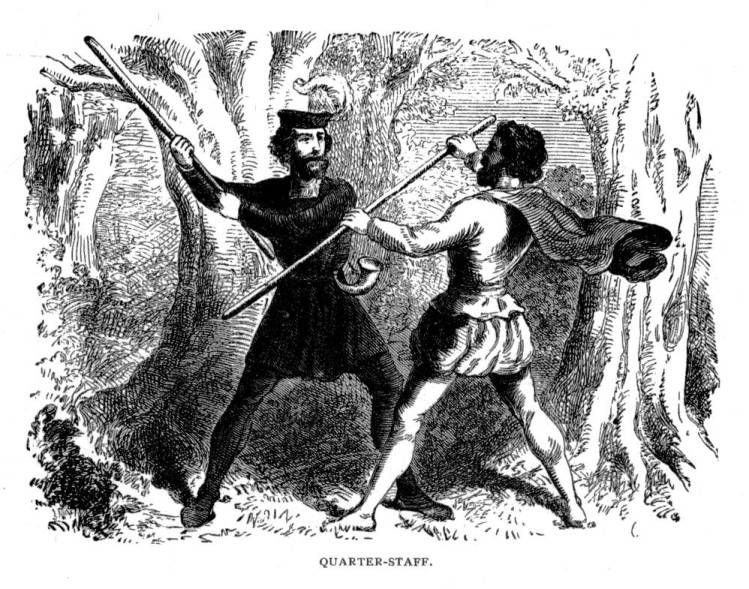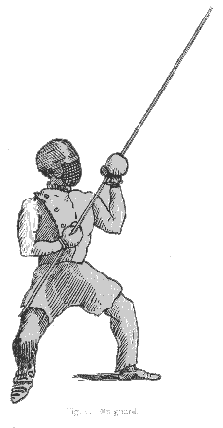|
A quarterstaff (plural quarterstaffs or quarterstaves), also short staff or simply staff is a traditional European pole weapon, which was especially prominent in England during the Early Modern period. The term is generally accepted to refer to a shaft of hardwood from 6 to 9 feet (1.8 to 2.7 m) long, sometimes with a metal tip, ferrule, or spike at one or both ends. The term "short staff" compares this to the "long staff" based on the pike with a length in excess of 11 to 12 feet (3.4 to 3.7 m). The name "quarterstaff" is first attested in the mid-16th century. The "quarter" probably refers to the means of production, the staff being made from hardwood of a tree split or sawn into quarters (as opposed to a staff of lower quality made from a tree branch). In his "Paradoxes of Defence" (1599), the English Master-at-Arms George Silver wrote: The Short Staffe is most commonly the best weapon of all other, although other weapons may be more offensive, and especially against many weapons together, by reason of his nimbleness and swift motions, and is not much inferior to the Forest Bille, although the Forest Bille be more offensive, the Short Staffe will prove the better weapon. From "Paradoxes of Defence" (1599), the English Master-at-Arms George Silver The quarterstaff was closely identified with sport and civilian self-defence, as a weapon of expedience used by travellers or in formal duels. By the early 1700s the weapon was commonly employed in public prize-fights, with the winner receiving both gate-money and the proceeds of wagering. The famed English stage gladiator James Figg promoted the art, along with backswording and pugilism, in bouts at Southwark Fair, and after his retirement from the stage in 1735 he taught it to young aristocrats at his own School of Arms in London's Oxford Street. There do not appear to be any records of recreational quarterstaff-play between 1748 and 1870, probably because during this period armed prize-fighting was virtually replaced by the new sport of boxing. Quarterstaffing was militarily obsolete and does not appear to have been a popular rural pastime, so it is possible that the art effectively became extinct. Quarterstaves in use, from Old English Sports, Pastimes and Customs, published 1891. Even armed with lightweight bamboo weapons, the knees and shins, groin, hands, temples, throat, and eyes were still vulnerable to serious, even if accidental, injury. By 1870, however, amateur quarterstaff fencers could choose from a diverse range of protective equipment designed for other sports. Between 1820 - circa 1850, the mask used by fencers (more accurately, "foilists") had been a simple wire mesh screen across the face. In response to the demands of heavier weapons such as the singlestick and training bayonet, mask designs began to incorporate hardened leather panels to protect the top and sides of the head, or helmet attachments woven out of strong wicker. The facial mesh was strengthened and reinforced with an internal framework of heavy wire that reduced denting and the chances of penetration. By the 1880s the Army had commissioned the "military broadsword helmet" for use in training cavalry soldiers, with additional protection for the back of the head. This design is recommended in both the McCarthy and Allanson-Winn quarterstaff texts. Protection gear for quarterstaff fighting By the late 1860s gladiatorial stage combats were a thing of distant memory, and the quarterstaff was most widely associated with the legendary outlaw hero of Sherwood Forest. Victorian England was in the grip of Robin Hood fever, and hundreds of books, songs, plays and poems were produced, commemorating and elaborating his adventures. A key incident in these stories, instantly familiar even today, is Robin Hood's quarterstaff match with Little John, taking place on a bridge over a shallow stream. It is not unlikely that the recreational quarterstaff play of the later Victorian period was influenced as much by the popularity of the Robin Hood legends as by the memory of Figg and his peers fighting on the stage at Southwark Fair. Gladiatorial fight 1870. Paulus Hector Mair in his martial arts compendium (1540s) details techniques of fighting with the staff in the German school of fencing of the Renaissance. There is some variation as to the proper way to hold a quarterstaff. According to the 16th to 18th century writings of Silver, Swetnam and Wylde, the quarterstaff is held with the back hand at the butt end of the staff and the other hand about a foot to a foot and a half (30 to 45 cm) above it. According to the 14th and 16th century writings of Johannes Liechtenauer and Paulus Hector Mair, the quarterstaff is held with the back hand a hand’s breadth from the butt end of the staff, and the other hand up to the middle of the staff. This is likely because of the transition of techniques from quarterstaves to polearms in Mair’s compendium. Of these the low guard is considered the central guard. Blows were primarily delivered downwards either directly or at angles. Parries of blows to the legs were done either by lifting the leg away from the line of attack or by thrusting one end of the staff into the ground and releasing the foremost hand which was in danger of being struck. Thrusts (called "darts" by Wylde) were often performed with the release of the forward hand and a step with the forward leg like a fencing lunge, stretching forward the back hand as far as possible. Longer thrusts were delivered with a full step forward with the back leg accompanying the back hand. It was recommended that when delivering a blow that at the end of it the back leg and foot should be compassed about so as to fall roughly into a line with the front foot and the point of the weapon. The same circling round of the back leg was applied to parries also. Singularly among the three authors, Swetnam recommends preference of thrusting over striking. Silver and Wylde describe striking and thrusting as equally valid attacks. The position with one hand held at the quarter and the other at the middle of the staff is not found in these early modern manuals, but it is described in the quarterstaff manuals published in the late 19th century, e.g. McCarthy (1883): "both hands should be 2 feet 6 inches [76 cm] apart, and the same distance from each end". 1542 - Paulus Hector Mair - Opus Amplissimum de Arte Athletica (MSS Dresd.C.93C.94)
9 Comments
11/23/2023 02:58:41 am
Sellers should be aware of the weight measurement used, with troy ounces being standard in gold transactions.
Reply
12/1/2023 09:36:09 pm
Our Clinic Sexologist in delhi fulfills all the categories that the best sexologist in delhi requires.
Reply
12/8/2023 01:31:34 am
The comprehensive guides on your blog have been instrumental in my own learning journey. Thank you for being a reliable source of information. Experience a quiet and peaceful restroom environment with our noise-resistant toilet partitions.
Reply
12/8/2023 10:17:23 pm
The commitment to staying unbiased and presenting different perspectives is a breath of fresh air. It fosters a healthy environment for open-minded discussion. Expert in creating temperature-controlled cubicles for extreme climate conditions.
Reply
12/10/2023 09:09:32 pm
Your commitment to addressing reader questions and comments demonstrates a genuine interest in fostering a community of learners. Choose toilet partitions with customizable door options to create a distinctive restroom entrance.
Reply
4/17/2024 10:24:42 pm
Whereas there is plenty of availability of sexologist treatment in delhi but Dr. P.K Gupta has always distinguished its reflection amongst all.
Reply
5/2/2024 01:29:54 am
Sexologist Doctor for Male Near Me in Delhi: Find specialized care tailored for men with a sexologist doctor for males near you in Delhi. These experienced practitioners offer comprehensive evaluations and personalized treatment plans for male sexual health concerns, including erectile dysfunction and premature ejaculation. With a focus on patient comfort and confidentiality, sexologist doctors for males in Delhi provide compassionate support and effective solutions to improve sexual wellness and satisfaction. Through advanced therapies and evidence-based practices, they empower men to overcome obstacles and achieve healthier, more fulfilling sexual lives.
Reply
Leave a Reply. |
MarkoUndermaster of historical fencing ArchivesCategories
All
|






 RSS Feed
RSS Feed
